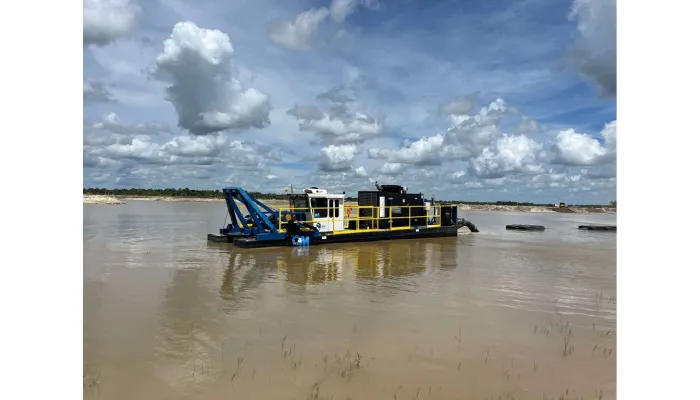Dredging is an important process that involves removing sediment and debris from water bodies, ensuring safe navigation and aiding in environmental cleanup. For beginners, understanding the types of dredge equipment is essential. Suction dredges are popular, with variations like cutter suction and trailing suction hopper dredges focusing on different materials. Mechanical dredges, including bucket and grab types, physically scoop up sediment. The applications range from harbor maintenance to land reclamation and flood control efforts. Dewatering techniques play a crucial role in handling dredged materials responsibly while minimizing environmental impact. This introductory guide helps new users grasp the complexities of wastewater dredging effectively.
1. Understanding the Dredging Process
Dredging is a crucial activity that involves the excavation, removal, and transportation of sediment and debris from the bottom of water bodies. This process is essential for maintaining safe water depths in navigable waterways, allowing boats and ships to travel without hindrance. Dredging can also play a vital role in environmental cleanup efforts, as it helps to remove contaminants from the waterbed, thereby improving water quality.
The dredging process can be executed through mechanical or hydraulic methods. Mechanical dredging employs equipment such as bucket dredges that physically lift sediment, while hydraulic dredging uses powerful pumps to create suction, drawing in a mixture of water and sediment. Both techniques serve various applications, from maintaining small canals to managing large ports.
The materials dredged can vary widely, including sand, silt, clay, and sometimes even hazardous substances. It’s important to note that dredging activities can significantly impact local ecosystems. Therefore, careful planning and adherence to regulations are necessary to protect aquatic habitats and ensure sustainable practices. Many dredging projects are also part of broader environmental restoration efforts, aimed at revitalizing degraded waterways and enhancing their ecological health.
2. Exploring Types of Dredge Equipment
Dredge equipment comes in two main types: hydraulic and mechanical. Hydraulic dredges, like suction dredges, are known for their efficiency in removing soft materials from the waterbed. These dredges use powerful pumps to create suction, drawing a mixture of water and sediment. A specific kind of hydraulic dredge, the cutter suction dredge (CSD), is equipped with a cutter head to break up compacted materials, making it versatile across various soil types. On the other hand, trailing suction hopper dredges (TSHDs) are self-propelled vessels that can transport dredged materials over long distances, which is particularly useful in larger projects.
Mechanical dredges employ physical means to remove sediment, making them ideal for harder materials or precise excavation. Bucket dredges are one common type, utilizing buckets attached to a ladder for excavation, effectively working in shallow waters and confined areas. Grab dredges, using a clamshell grab, are suitable for selective dredging, minimizing disturbance to the surrounding environment. Environmental dredges are specifically designed to reduce the spread of contaminants during dredging, ensuring that the operation is as eco-friendly as possible.
Each type of dredge offers unique advantages depending on the specific job requirements, making it essential to choose the right equipment for project success.
3. Applications of Dredging Equipment
Dredging equipment finds a variety of applications across different sectors. In ports and harbors, dredging is vital for maintaining safe navigation by removing sediment buildup that can impede vessel movement. It also plays a critical role in infrastructure projects, such as constructing bridges and tunnels beneath water bodies, ensuring these structures remain accessible and functional. Recreational areas benefit too; dredging is key in creating and maintaining marinas and beaches, providing safe and enjoyable spaces for the public.
Moreover, dredging supports environmental efforts by facilitating the restoration of wetlands and natural habitats, which are essential for biodiversity. The mining industry relies on dredging to access valuable underwater mineral deposits, helping to meet demands for resources. Additionally, dredging is crucial in flood management; by enhancing water flow capacity, it helps mitigate the risks associated with flooding.
In terms of environmental cleanup, dredging effectively removes hazardous materials from contaminated water bodies, contributing to cleaner ecosystems. Coastal protection projects often involve dredging to construct barriers or replenish eroding beaches, safeguarding coastal communities from natural threats. Land reclamation initiatives transform aquatic areas into usable land, promoting development and urban expansion. Lastly, dredging also supports scientific research by collecting sediment samples that provide valuable data about underwater environments.
4. Techniques for Dewatering Dredged Materials
Dewatering is essential for managing dredged materials, as it significantly reduces their volume and weight. This process helps make the handling and disposal of materials more efficient. Mechanical methods like centrifugation and filtration are commonly used. For instance, decanter centrifuges can quickly separate solids from liquids using centrifugal force. Geotextile tubes are also popular; they allow water to drain out while retaining the solids, making them an effective solution for many projects. In larger operations, drying beds can be utilized, where natural evaporation helps in dewatering the materials over time.
Consolidation methods can also aid in settling solids from a slurry, making it easier to separate the water. In some cases, chemical additives are introduced to enhance the dewatering process, improving efficiency and effectiveness. The choice of technique often depends on the type of material being dredged and the specific conditions at the site. Proper dewatering techniques not only lead to reduced disposal costs but also facilitate the potential reuse of dredged materials, making the entire process more sustainable. Monitoring water levels during dewatering is crucial to ensure efficiency and effectiveness in achieving desired outcomes.
5. Environmental Factors in Dredging
Dredging is not without its challenges, particularly when it comes to the environment. The process can disrupt local ecosystems and habitats, making thorough assessments crucial before any operation begins. One significant concern is sediment resuspension, which can affect water quality and harm aquatic life. Therefore, monitoring for contaminants in the dredged material is essential to ensure safety for both the environment and public health.
Dredging activities should also take into account seasonal wildlife patterns. For example, operations might need to be adjusted or postponed during spawning seasons to protect vulnerable species. To mitigate negative impacts, measures such as silt curtains can be employed to limit the spread of sediment into surrounding waters. Additionally, creating buffer zones around sensitive areas can provide extra protection during dredging operations.
Once dredging is complete, post-dredging restoration efforts are vital for aiding the recovery of affected habitats. Engaging local communities in these efforts can enhance project acceptance and promote environmental stewardship. Compliance with environmental regulations is not just a legal requirement but also a crucial step in safeguarding water quality and wildlife. Lastly, ongoing environmental monitoring is necessary to evaluate the long-term effects of dredging, ensuring that any adverse impacts are addressed effectively.
6. How to Choose Dredging Equipment
Choosing the right dredging equipment is crucial for the success of your project. Start by assessing the project scope, including the type and volume of material you need to dredge. Different materials, such as sand, mud, or contaminated sediments, will require specific types of equipment. Next, consider the depth of dredging required and the site conditions, like water currents or obstacles on the seabed.
Evaluate the proximity of disposal sites, as this can greatly affect logistical efficiency and costs. Understanding environmental impacts and any regulatory requirements is equally important; some areas may have strict guidelines on dredging practices. Each type of dredge equipment has unique capabilities, so familiarize yourself with these to ensure you select the best fit for your needs.
Budget is a key factor, so weigh the cost-effectiveness of different options against their performance and reliability. Consulting with experienced professionals or contractors can provide valuable insights and recommendations tailored to your specific situation. Don’t overlook maintenance and operational support, as reliable equipment often requires ongoing care to function effectively.
Lastly, consider your project’s timeline; the choice of equipment can influence how quickly you can complete the work. Look for equipment that offers flexibility for future projects, ensuring it can adapt to different dredging tasks as your needs evolve.
7. Advantages of Dredging Projects
Dredging projects bring numerous advantages to both communities and economies. One of the most significant benefits is the enhancement of navigation. By maintaining and deepening waterways, dredging improves trade routes, making transportation more efficient. This facilitates economic development, as businesses gain better access to shipping lanes and markets. Additionally, the dredged materials can be repurposed for construction, which lowers project costs.
Beyond economic benefits, dredging can create new recreational opportunities, such as fishing and boating, which can boost local tourism and increase property values. It also plays a crucial role in restoring aquatic environments, promoting biodiversity by creating habitats for various species. Environmental restoration contributes not only to the health of ecosystems but also to community well-being.
Coastal protection is another vital advantage of dredging. By managing sediment and replenishing eroded coastlines, dredging helps safeguard communities from the impacts of erosion and storm surges. Furthermore, it supports flood prevention strategies by improving the capacity of waterways to handle excess water, thus reducing risks to infrastructure and lives.
Reclamation projects, which transform dredged materials into new land, open up possibilities for agriculture and urban development. Finally, dredging can significantly improve water quality by removing pollutants, leading to cleaner and healthier water bodies. In essence, dredging projects provide multifaceted benefits that enhance the quality of life and economic vitality in surrounding areas.
8. Final Thoughts on Dredging Equipment
Selecting the right dredging equipment is more than just a logistical choice; it can define the success of a project and its environmental impact. Understanding the various types and techniques of dredging is crucial for effective project planning. Each project presents its own set of challenges, requiring a balance between operational efficiency and environmental protection. As technology advances, new equipment and methods are emerging that prioritize sustainability, aiming to reduce ecological footprints while enhancing performance.
Collaboration among stakeholders—engineers, environmentalists, and local communities—can lead to better project outcomes and more responsible dredging practices. Training and education are also vital for those entering the industry, ensuring they are equipped with the knowledge to navigate the complexities of dredging. Awareness of regulations and best practices is essential for compliance, helping to safeguard aquatic ecosystems while allowing for necessary resource management. Dredging will continue to play a vital role in how we manage our water resources and environments, making informed choices and practices all the more important.
Resource URL:
https://www.imsdredge.com/lagoon-dredging/
https://en.wikipedia.org/wiki/Best_management_practice_for_water_pollution

Mary Burns is a dedicated writer focusing on health and fitness topics. With a passion for promoting wellness and vitality, Mary shares her knowledge and expertise through engaging and informative blog posts.




